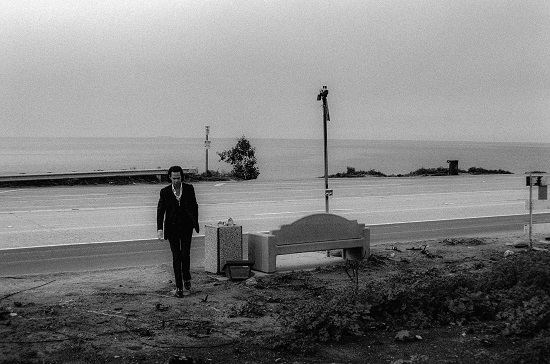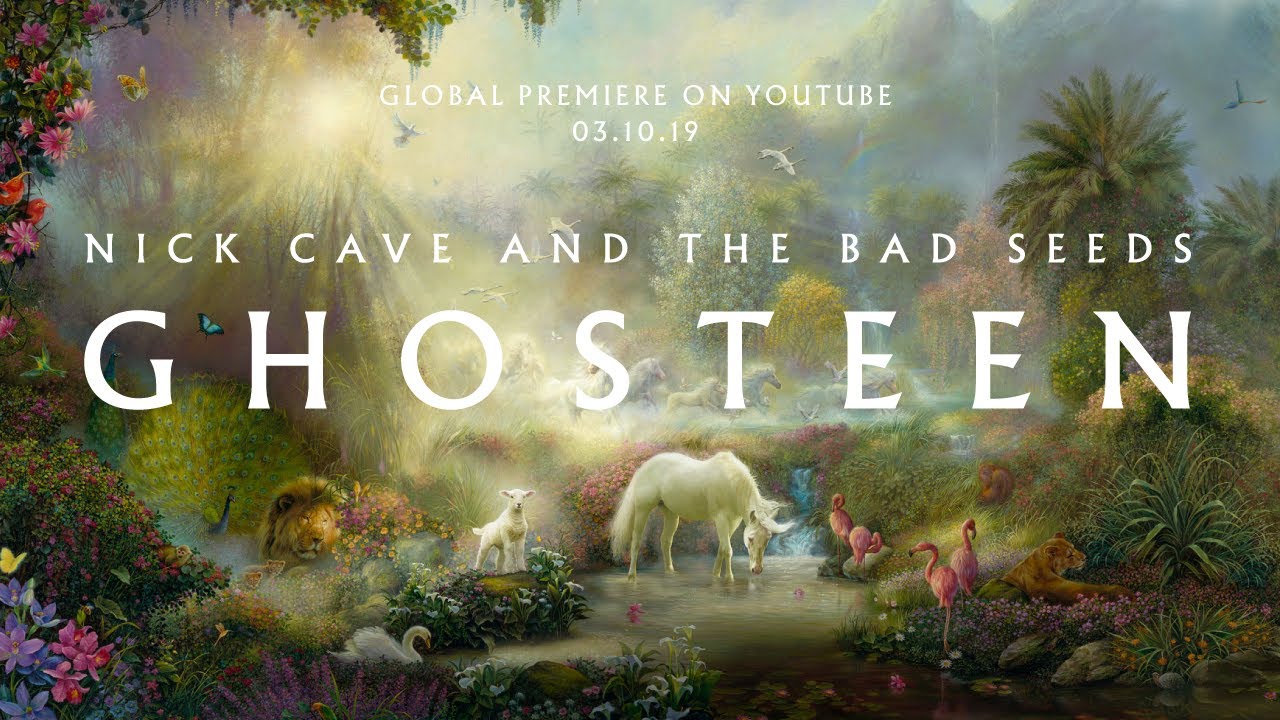In the thirtieth entry of ‘The Red Hand Files’, where Nick Cave answers questions from his fans, he responded to an enquiry as to how his wife Susie was doing, four years after the couple’s teenage son was killed in a tragic accident. “I learned the appalling meaning of the words ‘inconsolable’ and ‘helpless’ – and I never knew a person could cry for so long,” Cave wrote in reply. “But I have also seen a woman ultimately step from that room, changed – defiant and scoured clean by grief; a woman with a mutinous and ferocious grace, now more open, daring and creative than ever; a woman who has simply defied the cosmic odds and bloomed.” On the evidence of Ghosteen, the same can be said of her husband. “The very thing we thought would destroy us, now becomes a fierce source of creative power, as if our departed are breathing an essential energy through us, drawn from a wellspring deep within the trauma itself,” he continues in that letter.
In the first Red Hand File, he spoke about how after his son’s death: “We all needed to draw ourselves back to a state of wonder. My way was to write myself there […] I found with some practise the imagination could propel itself beyond the personal into a state of wonder. In doing so the colour came back to things with a renewed intensity and the world seemed clear and bright and new.” And Ghosteen, above all else, is a truly wondrous album. I mean that not in the sense that it is simply very good, but that it inspires a sense of pure and all-encompassing wonder, teeming with wild and otherworldly images, with galleon ships flying out into the sky and sailing around the sun, of stampeding horses with manes of fire. Cave transforms photons flung from a dying star into fireflies trapped in a jar, and makes the father of the fairy tale Three Bears float upwards to the moon. Its sonic palette is golden and lush, with slow and noble tides of synth, distorted chimes and rushes of chorus. His words are slow and deliberate, always front and centre however opulent the music. His voice is more powerful, more assured than before, but crucially still cracked, sometimes wavering out of tune.

Photo by Matthew Thorne
That wonder is there in its front cover, where earthly birds, beasts and flowers are bathed in heavenly light so that they seem almost mythical. At first a white stallion, drinking from a spring, looks like a unicorn, but look closer and the horn is just a flick of its lush mane. Look once more, and you’ll see seven more horses, galloping in the distance, shimmering and ghostly as their white coats blend into the light. That ‘colour coming back to things’ that Cave wrote about is all here, the intensity not just renewed, as he put it, but more powerful than ever before.
On ‘Sun Forest’, which is the most beautiful-sounding music The Bad Seeds have ever recorded, Cave writes himself into a scene not dissimilar from the front cover. “I lay in the forest amongst the butterflies and the fireflies / And the burning horses and the flaming trees/ As a spiral of children climb up to the sun.” Children appear often amid the wonderous scenes, and often while climbing, rising and transcending. In the Red Hand Files Cave speaks of his aim to “write authentically, that deals with all manner of issues but does not turn its back on the issue of the death of my child.”
On ‘Galleon Ship’ Cave conjures a vessel that sails “ghostly around the morning sun / as the city rises up, rises up”. On ‘Ghosteen’, Cave writes about the three bears: “Mama bear holds the remote, papa bear he just floats / And baby bear, he has gone to the moon in a boat, on a boat.” Where there is movement on the record, it is often fantastical, drawing on the rich and pure kind of wonder of children’s stories. Cave has written about the influence Pinocchio has held over his writing over the last few years, calling the story “one of the most moving in all literature.” Writing to another man who has lost a child, he discusses the sequence in which Pinocchio’s creator and father is trapped in the belly of a great whale, from which only his son can rescue him. “After a while, I found the spirit of my son braved the sea and found and entered the whale, and lighting the fire, convulsed the whale and released me from its unlit interior, ‘blasting me ashore’,” Cave says.
Spirits float and dance all over Ghosteen. The album’s title, Cave revealed at his ‘Conversations with…’ event in New York last month, comes from an Irish tinker’s book, in reference to a wandering ghost that the author believes has possessed his crying child. In Irish, the suffix ‘ín’, anglicised to ‘-een’, is used to denote something small, but also something benevolent. “It’s added to many words like ‘it’s just a mouseen’ therefore nothing to be afraid of, harmless. Or, about a young boy, ‘he’s a little maneen’,” the anthropologist Sharon Gmelch tells tQ. It is perhaps worth noting that the tinkers of Ireland, in folklore said to have supernatural powers of fertility, and to eat campfire ash to maintain their health, speak a coded language called ‘Shelta’, or ‘Gammon’. “It is a true ‘cant’ or form of disguised communication whose purpose is to conceal the meaning from outsiders,” Gmelch describes in her book Tinkers and Travellers: Ireland’s Nomads.
The ‘Ghosteen’ is by its nature, then, a somewhat mysterious presence, but we can probably say that it is both small and benevolent; a friendly, childlike ghost. Given the context, we might assume that Ghosteen is therefore Cave’s son, or his ‘maneen’, as the tinkers might have it, but one of the record’s defining features is how Cave blurs those obvious lines. As he himself said when the record was announced, “Ghosteen is a wandering spirit,” and it wanders in more than a physical sense. On the title track he sings: “A ghosteen dances in my hand / Slowly twirling, twirling all around /Glowing circle in my hand / Dancing, dancing, dancing all around.” But then, on ‘Ghosteen Speaks’, he sings: “I am within you, you are within me / I am beside you, you are beside me”. Part of the song seems as if it could be a description of one of Cave’s gigs, and the sense of openness and communion that has come to define them since Skeleton Tree. “I think they’re singing to be free / I think my friends have gathered here for me.” Ghosteen feels not like a single figure, but a kind of energy; a spirit in the shared sense, rather than the singular.
Cave has talked many times about how when his son died, he felt as if he himself had departed this earth, such was the darkness that consumed him. Of his wife, too, he wrote on the Red Hand Files: “I have seen life lived in a darkened room, essentially a tomb, crumpled around a memory, as if to be dead herself somehow brought her closer to the spirit of her departed child.” Just as the spirit of ‘Ghosteen’ seems to mingle with his own, so too does the inevitability of his own death mingle with that of his son’s. Parenthood and childhood become one and the same. “We grieving fathers, all of us, begin our time in the vast and darkened belly of the beast,” he writes in The Red Hand Files. “We also have become the child […] and perhaps some dark force had always destined that to be.”
The wonder of Ghosteen is often created via this technique of blurring lines. It happens on grand scales like where religion melds with astrophysics – “Jesus lying in his mother’s arms / Is a photon released from a dying star” – and on small ones too – the ‘King of Rock and Roll’ with his ‘black jelly’ hair who appears on ‘Spinning Song’ could be Elvis Presley, but it might also recall a young Nick Cave. The most important, however, is the boundary between wonder and reality. On Ghosteen Cave leads us on an obsessive, almost desperate pursuit of the wondrous, and so strong are his creative powers that he finds it in a myriad of places, collecting and presenting them together as a singular work of art, a kaleidoscopic vision that is unlike anything he’s done before. But for all of this it would be too simplistic to view the record as just a catalogue of transcendent moments. He takes care to lace the work with reminders that these images and stories are, for all their brilliance, still fantasies. When Cave sings about his flying galleon ship, he prefaces it: “If I could.”
Wonder has become a coping mechanism, a way to lift Cave from the deathly mire of grief, to acknowledge his loss, rediscover colour and reaffirm his abilities as an artist. But it is not closure. “Horses are just horses and their manes aren’t full of fire / The fields are just fields, and there ain’t no Lord / And everyone is hidden, and everyone is cruel / And there’s no shortage of tyrants, and no shortage of fools / And the little white shape dancing at the end of the hall / Is just a wish that time can’t dissolve at all,” he sings on ‘Bright Horses’. The horse on the album’s front cover might look like a unicorn, but that horn is still nothing more than a conveniently-wisped knot of hair.

Photo by Matthew Thorne
Cave ends the album by making it clear. He tells the story of Kisa Gotami, a woman who lived in the same period as Gautama Buddha. When Kisa’s baby fell sick and died, in desperation and denial she sought the Buddha, who told her he could resurrect her child if she could bring him a mustard seed from a house where no one had died. Of course, there is nowhere, and no one without death, and in the end Kisa accepted defeat, buried her baby, then returned to Buddha to enter the first stage of enlightenment. The musician, you sense, is still behind her on that path. “Everybody’s losing someone / Everybody’s losing someone,” he repeats, the final words as the album fades out. “It’s a long way to find peace of mind.”
The power of imagination, as demonstrated on Ghosteen, is an immensely powerful weapon in the face of what might seem insurmountable horror, a tool to re-establish wonder, and to absorb grief. But as Cave wrote to a fellow bereaved father: "I see a day when my son can let go of my hand and return to his spirit-form – the child – and be free. I can become his father again. That day is coming, but is not here yet, for you or for me. We are still, as you said, on some level, ‘living in another world’ with the departed."



